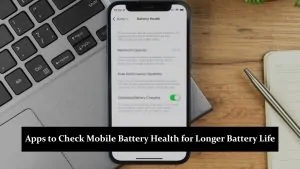A battery is an essential component in portable electronic devices that stores electrical energy and supplies power. It enables devices like smartphones, tablets, laptops, and wearable tech to operate without being plugged into an electrical outlet. Batteries convert chemical energy into electrical energy, providing the necessary power to run the device’s hardware and software.
Types of Batteries
- Lithium-Ion (Li-Ion) Batteries: The most common type of battery used in modern portable devices. Li-Ion batteries are known for their high energy density, long lifespan, and ability to be recharged many times. They are lightweight and provide a good balance between capacity and size, making them ideal for mobile devices.
- Lithium-Polymer (Li-Po) Batteries: Similar to Li-Ion batteries, Li-Po batteries are lightweight and have a high energy density. They are flexible in shape, allowing manufacturers to design thinner and lighter devices. Li-Po batteries are commonly used in smartphones, tablets, and some laptops.
- Nickel-Metal Hydride (NiMH) Batteries: Although less common in modern devices, NiMH batteries were once popular in portable electronics. They have a lower energy density compared to Li-Ion and Li-Po batteries but are more environmentally friendly.
- Nickel-Cadmium (NiCd) Batteries: These batteries have largely been replaced by newer technologies due to their lower energy density and environmental concerns. They were once used in portable electronics but are now mostly found in older devices or specialized applications.
Key Features of a Battery
- Capacity: Measured in milliampere-hours (mAh) or watt-hours (Wh), capacity indicates the amount of energy a battery can store. Higher capacity batteries can power a device for longer periods between charges.
- Voltage: The voltage of a battery determines the amount of electrical potential it can provide. Most portable devices use batteries with a nominal voltage of around 3.7V.
- Charge Cycles: A charge cycle refers to one complete discharge and recharge of a battery. The lifespan of a battery is often measured in charge cycles, with most modern batteries offering several hundred to a thousand cycles before significant degradation occurs.
- Battery Life: Refers to the duration a battery can power a device on a single charge. Battery life is influenced by factors such as the device’s power consumption, battery capacity, and the efficiency of the hardware and software.
Uses of Batteries
- Portable Devices: Batteries power a wide range of portable electronics, including smartphones, tablets, laptops, cameras, and wearable devices. They provide the mobility and convenience of using these devices without being tethered to a power outlet.
- Electric Vehicles (EVs): Batteries are a crucial component in electric vehicles, providing the energy needed to drive electric motors. The capacity and efficiency of the battery directly impact the range and performance of the vehicle.
- Backup Power: In uninterruptible power supplies (UPS) and emergency lighting systems, batteries provide backup power during electrical outages, ensuring continuous operation.
- Energy Storage: Batteries are used in renewable energy systems, such as solar and wind, to store excess energy generated during peak production times. This stored energy can be used when production is low or demand is high.
Importance of the Battery
The battery is a vital component that determines the portability and usability of electronic devices. Its capacity and efficiency affect the device’s operating time and overall user experience. As technology advances, the demand for longer-lasting, faster-charging, and more efficient batteries continues to grow. Innovations in battery technology are crucial for the development of more powerful and energy-efficient devices, as well as for the expansion of electric vehicles and renewable energy solutions.



